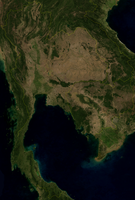
Photo from wikipedia
The fine particulate matter (PM2.5) was collected at academic campus of Indian Institute of Technology, Delhi, India from January-December 2017. The PM2.5 samples were analysed for carcinogenic (Cd, Cr, As,… Click to show full abstract
The fine particulate matter (PM2.5) was collected at academic campus of Indian Institute of Technology, Delhi, India from January-December 2017. The PM2.5 samples were analysed for carcinogenic (Cd, Cr, As, Ni, and Pb) and non-carcinogenic (V, Cu, Zn, Fe) trace metals and their elicited effects on carcinoma epithelial cell line A549. Toxicological testing was done with ELISA kit. Same analyses were repeated for standard reference material (NIST-1648a) represents urban particulate matter. The student-t test and spearman correlation were used for data analysis. The seasonality in PM2.5 mass concentration and chemical composition showed effect on biological outcomes. The PM2.5 in post-monsoon and winter had higher amount of trace metals compared to mass collected in pre-monsoon and monsoon. Following the trend in PM mass concentration significantly (p < 0.5) lower cell viability was observed in post-monsoon and winter compared to other two seasons. NIST UPM 1648(a) samples always had higher cytotoxicity compared to ambient PM2.5 Delhi sample. Strong association of Chromium, Nickel, Cadmium, and Zinc was observed with cell viability and reactive oxygen species (ROS) production. In winter IL-6, IL-8 production were 2.8 and 3 times higher than values observed in post-monsoon and 53 and 9 times higher than control. In winter season trace metals As, Cu, Fe, in pre-monsoon Cr, Ni, As, Pb, V, and Fe, in post-monsoon Cd and V strongly correlated with ROS generation. ROS production in winter and pre-monsoon seasons found to be 2.6 and 1.3 times higher than extremely polluted post-monsoon season which had 2 to 3 times higher PM2.5 concentration compared to winter and pre-monsoon. The result clearly indicated that the presence of Fe in winter and pre-monsoon seasons catalysed the ROS production, probably OH˙ radical caused high cytokines production which influenced the cell viability reduction, while in post-monsoon PM majorly composed of Pb, As, Fe and Cu and affected by photochemical smog formation showed significant association between ROS production with cell viability. Overall, in Delhi most toxic seasons for respiratory system are winter and post-monsoon and safest season is monsoon.
Journal Title: Chemosphere
Year Published: 2021
Link to full text (if available)
Share on Social Media: Sign Up to like & get
recommendations!